The Spending In Digital Customer Experience and Engagement Solutions Market is estimated to be valued at USD 439.0 million in 2025 and is projected to reach USD 687.4 million by 2035, registering a compound annual growth rate (CAGR) of 4.6% over the forecast period.
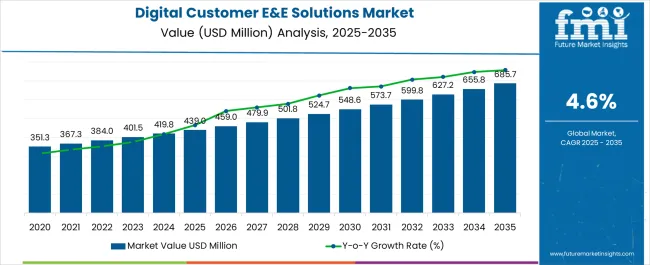
| Metric | Value |
|---|---|
| Spending In Digital Customer Experience and Engagement Solutions Market Estimated Value in (2025 E) | USD 439.0 million |
| Spending In Digital Customer Experience and Engagement Solutions Market Forecast Value in (2035 F) | USD 687.4 million |
| Forecast CAGR (2025 to 2035) | 4.6% |
The spending in digital customer experience and engagement solutions market is advancing rapidly, fueled by the shift toward personalized, data-driven interactions and the rising adoption of cloud-based engagement platforms. Corporate disclosures and technology press releases have emphasized that organizations are investing heavily in omnichannel solutions to strengthen customer loyalty and enhance brand differentiation. Businesses are leveraging artificial intelligence, analytics, and automation to deliver contextual, real-time engagement across multiple digital channels.
Regulatory focus on data privacy and compliance has further influenced investment patterns, encouraging enterprises to adopt secure and transparent customer engagement frameworks. The increasing use of mobile-first platforms, coupled with heightened customer expectations for seamless digital interactions, has accelerated market expansion.
Looking forward, the demand for advanced engagement solutions will continue to grow as industries such as banking, retail, and telecommunications prioritize digital-first strategies to improve customer satisfaction and retention, making this market a cornerstone of modern customer relationship management.
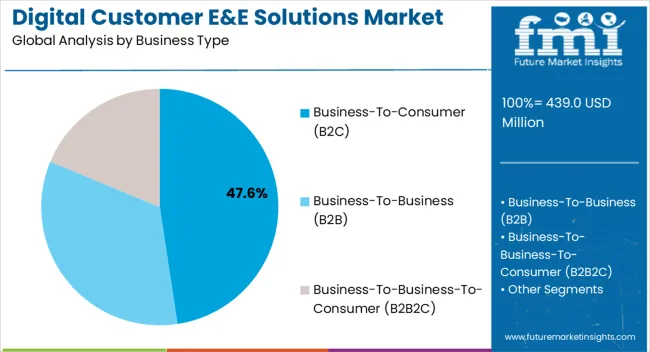
The Business-To-Consumer (B2C) segment is projected to hold 47.6% of the spending in digital customer experience and engagement solutions market revenue in 2025, affirming its position as the leading business type. Growth in this segment has been driven by the rising need for personalized engagement across e-commerce, retail, and service-based sectors, where direct customer interaction defines business success.
Companies in the B2C landscape have prioritized digital solutions that enhance customer journeys through targeted campaigns, loyalty programs, and self-service platforms. Consumer expectations for real-time responses and seamless transactions have compelled businesses to invest in integrated digital ecosystems.
Press releases from technology firms have highlighted accelerated adoption of cloud-based platforms in B2C markets, enabling scalability and cost optimization. With a focus on retaining customers and improving lifetime value, the B2C segment is expected to sustain its leadership role in driving overall spending in this market.
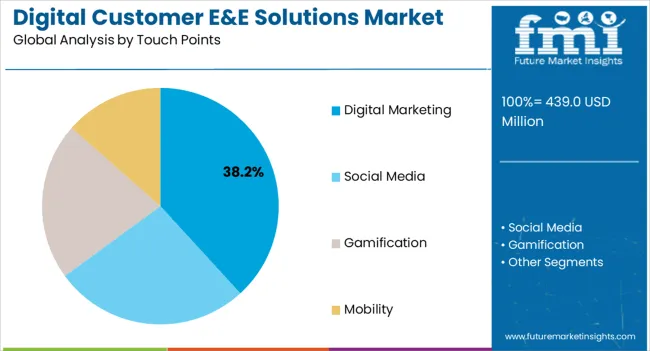
The Digital Marketing segment is forecasted to account for 38.2% of the market revenue in 2025, securing its position as the top touch point. This growth has been underpinned by the critical role of digital marketing in influencing purchasing decisions and fostering customer engagement.
Businesses have increasingly invested in data analytics, content personalization, and programmatic advertising to improve campaign effectiveness. Social media platforms, mobile apps, and search engines have become vital channels for reaching customers, amplifying the need for cohesive digital marketing strategies.
Investor updates from technology companies have emphasized spending on AI-driven tools that optimize ad placements, measure customer sentiment, and automate engagement processes. The scalability and measurable ROI offered by digital marketing channels have made them indispensable in customer experience strategies. As competition intensifies across industries, the Digital Marketing segment is expected to remain at the forefront of engagement initiatives.
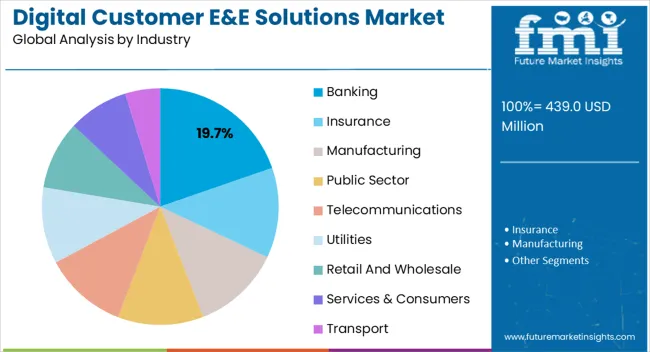
The Banking segment is projected to contribute 19.7% of the market revenue in 2025, making it the leading industry in spending on digital customer experience and engagement solutions. Growth in this segment has been driven by the increasing digitization of banking services and customer demand for secure, frictionless financial interactions.
Financial institutions have invested heavily in omnichannel platforms, mobile banking apps, and AI-powered chatbots to enhance service efficiency and customer satisfaction. Regulatory requirements for transparency and secure communication have further influenced adoption.
Industry announcements have highlighted the banking sector’s shift toward hyper-personalized services, leveraging customer data to tailor financial advice and product recommendations. Additionally, heightened competition from digital-only banks and fintech players has compelled traditional institutions to accelerate digital transformation. With financial services being integral to everyday life, the banking sector’s continued investment in customer engagement solutions is expected to anchor its dominant position in the market.
The global market for spending on digital customer experience and engagement solutions expanded at a CAGR of 2.7% over the last five years.
The market growth is projected to benefit from the surge in the B2B customer expectation for an enhanced and personalized customer experience, leading to increased avenues for the key industry players shaping the spending in digital customer experience and engagement solutions industry in the forthcoming years.
The global spending in the digital customer experience and engagement solutions market is predicted to surge at a CAGR of 4.8% and record sales worth USD 687.4 million by the end of 2035. The United States may remain the leading market throughout the analysis period, accounting for over USD 69.2 million absolute dollar opportunity in the coming 10-year epoch.
In the forthcoming years, it is expected that the customer awareness segment of the spending in digital customer experience and engagement solutions market may experience a CAGR of 4.9%.
According to a 2025 survey, around 77% of customers tend to be better at being loyal to businesses offering marvelous services, which further expedites the customer analytics sub-segment of the customer awareness segment, which aids in improving customer experience and loyalty.
As of 2024, over 63% of companies across the globe are focusing more on customer experiences.
Findings of another market survey have noted that around 71% of the customers may discontinue using the services of a company if it is found that their data is shared without permission, a development that directly impacts the growth of the customer data management platforms under the customer awareness segment by solution.
Furthermore, at 2.1 billion, with nearly 30% of the global populace digitizing their shopping experience, the requirement for a personalized omnichannel experience is surging, leading industry players such as Amazon.com Inc.
in the retail and wholesale industry vertical to leverage customer analytics. All these attributes are anticipated to positively impact the spending in digital customer experience and engagement solutions market in the upcoming 10-year epoch.
The business-to-business segment by business type of spending in the digital customer experience and engagement solutions market may be witnessing a CAGR of 4.7 % in the upcoming 10-year epoch.
The business-to-business (B2B) segment by business type becomes convalescent when the B2B organizations work efficiently for customer experience enhancement. With the demand for personalization increasing among customers, B2B e-commerce and sales teams increasingly focus on customer data analytics.
A study has recently found that 80% of the B2B customer cohort post-pandemic tends to expect a buying experience similar to that of the business-to-customer (B2C) segment.
Besides, a 2024 study further estimates that by 2025, around 80% of the net B2B sales transactions may be happening via digital channels. More recently, in 2025, it is predicted that by the end of 2029, over 65% of the B2B sales may be transitioning to data-driven decision-making from intuition-based decision-making.
Nearly 75% of the B2B customers find themselves being extensively influenced by the social media segment by touch point, with 84% of senior executives using the platform to support purchase decisions.
Moreover, automation solutions pertaining to the business-to-business (B2B) segment are estimated to rise during the forthcoming years to keep up with the increasing trends of digitization across the globe.
With key players in the B2B segment focusing on marketing automation and personalizing customer experience and requirements, this segment is anticipated to positively impact the spending in digital customer experience and engagement solutions market.
Asia Pacific may continue to be lucrative for spending in the digital customer experience and engagement solutions market in the forthcoming years. Among the various attributes favoring the market in Asia Pacific, new product launches are also included.
In January 2024, the Cheetah Digital Customer Engagement Suite was launched in Japan, which provides business firms with immaculate ways of marketing to consumers. This also aids the 5.7% CAGR the country is set to witness by the end of 2035.
A recent survey noted that in India, enhancing customer experience across financial services, healthcare, retail, media, telecommunications, and travel may aid the unlocking of USD 200 billion in brand value, along with improving the total valuation of businesses by around 125 to 400%.
Also, taking into account the data related to the CX Index in India, around 80% of customers tend to recommend a brand after a satisfying experience, and only 35% may recommend it after a poor experience.
It is estimated that the North-American region may maintain its market share of more than 35% intact in the spending in the digital customer experience and engagement solutions market.
One of the key attributes associated with the growth of the spending in the digital customer experience and engagement solutions market in the region is the extensive surge in spending witnessed by digital marketing in both Canada and the United States.
As of 2024, the most beneficial advertising medium in Canada was digital media, standing at USD 439 billion in ad revenue, accounting for over half of the ad revenue generated in the nation. According to a March 2025 report, the churn rates associated with content streaming platforms in the United States are among the world's leading.
This attribute aids in augmenting the requirement for customer engagement solutions, which helps reduce churn rates, thus leading to a surge in customer engagement. All these factors are anticipated to augment the requirement for spending in the digital customer experience and engagement solutions market in the forthcoming years.
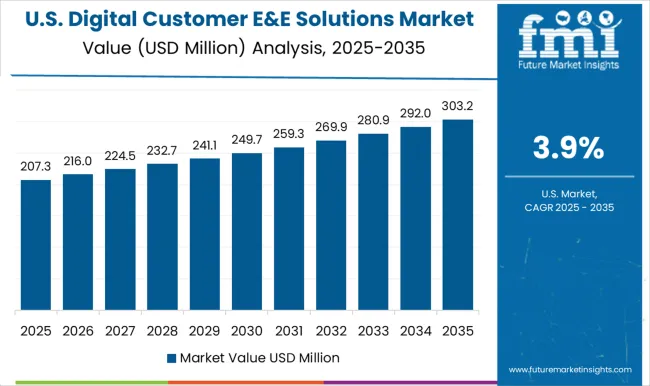
The United States commands a global market share of over 25% in the spending in the digital customer experience and engagement solutions market and may continue to keep it intact.
The country is expected to witness a CAGR of 5.2% coupled with an absolute dollar opportunity of USD 687.4 million to reach a total market valuation of USD 174.7 million by the end of 2035. The most popular form of advertising and marketing used across the industry verticals in the United States is the Social Media segment.
According to a recent report, as of 2024, around 91.9% of the United States business marketers with more than 100 employees tended to use social media for marketing and advertising. Additionally, over USD 153 billion was the cost associated with internet advertising and is estimated to surge ahead in the forthcoming years.
The market growth associated with social media is also expedited by the large cohort of social media users in the country, which is anticipated to increase further during the upcoming 10-year epoch.
Presently, with over 350.8 million people, 72.3% of the total United States population uses social media. Additionally, the United States is among the leading and most mature industries in the world pertaining to adopting B2B e-commerce. B2B e-commerce was valued at USD 6.7 trillion in the United States as of 2020.
The attributes contributing to this growth that may further expedite it in the forthcoming years are the consistent shift of B2B customers to online corporate purchases from the more conservative buying methods. All these attributes may expedite the growth of the Spending in the Digital Customer Experience and Engagement Solutions Market in the United States during the upcoming 10-year forecast period.
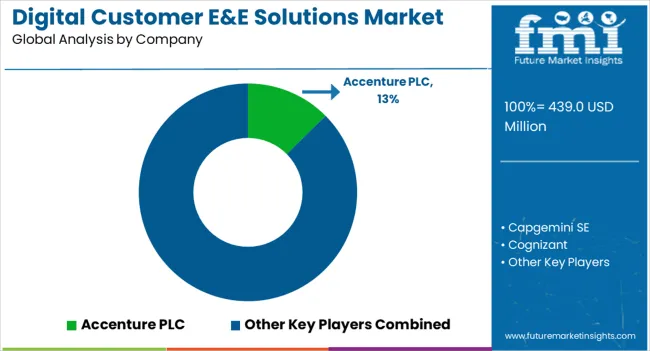
Accenture PLC, Capgemini SE, Cognizant, IBM Corporation, Liferay Inc., MEGA International, Orange Business Services, Tietoevry Corporation, SAS Institute Inc., KOFAX Inc., NCR Corporation, Tata Consultancy Services (TCS) Limited, Zendesk Inc., and SAS Institute Inc.
Are among the key players worldwide driving the competitive landscape of the market. Several companies are adopting strategies such as mergers, acquisitions, and partnerships to expand their product portfolio and simultaneously capitalize on the growing market demand.
Recent Developments
The global spending in digital customer experience and engagement solutions market is estimated to be valued at USD 439.0 million in 2025.
The market size for the spending in digital customer experience and engagement solutions market is projected to reach USD 687.4 million by 2035.
The spending in digital customer experience and engagement solutions market is expected to grow at a 4.6% CAGR between 2025 and 2035.
The key product types in spending in digital customer experience and engagement solutions market are business-to-consumer (b2c), business-to-business (b2b) and business-to-business-to-consumer (b2b2c).
In terms of touch points, digital marketing segment to command 38.2% share in the spending in digital customer experience and engagement solutions market in 2025.






Full Research Suite comprises of:
Market outlook & trends analysis
Interviews & case studies
Strategic recommendations
Vendor profiles & capabilities analysis
5-year forecasts
8 regions and 60+ country-level data splits
Market segment data splits
12 months of continuous data updates
DELIVERED AS:
PDF EXCEL ONLINE
Home Office Spending Market by Solution Deployment, Application & Region Forecast till 2025 to 2035
Cognitive Systems Spending Market Report – Growth & Forecast 2016-2026
Remote Learning Technology Spending Market Analysis by Technology Software, Technology Services, Learning Mode, End User and Region Through 2025 to 2035
Competency-based Education Spending Market
AI Systems Spending Market Report – Growth & Forecast 2017-2027
Industrial Security System Market Forecast Outlook 2025 to 2035
Industrial Film Market Forecast Outlook 2025 to 2035
Industrial Floor Mat Market Forecast Outlook 2025 to 2035
Injectable Drug Industry Analysis in North America Forecast Outlook 2025 to 2035
Inflatable Packaging Market Forecast and Outlook 2025 to 2035
Intimate Wash Care Product Market Forecast and Outlook 2025 to 2035
India Casino Tourism Market Forecast and Outlook 2025 to 2035
Industrial Insulation Market Forecast and Outlook 2025 to 2035
Industrial Process Water Coolers Market Forecast and Outlook 2025 to 2035
Industrial Grade Ammonium Hydrogen Fluoride Market Forecast and Outlook 2025 to 2035
Industrial Grade Sodium Bifluoride Market Forecast and Outlook 2025 to 2035
Inductive Arc Position Sensor Market Size and Share Forecast Outlook 2025 to 2035
Inductance Meters Market Size and Share Forecast Outlook 2025 to 2035
Industrial Evaporative Condenser Market Size and Share Forecast Outlook 2025 to 2035
In-building Wireless Market Forecast and Outlook 2025 to 2035

Thank you!
You will receive an email from our Business Development Manager. Please be sure to check your SPAM/JUNK folder too.
Chat With
MaRIA